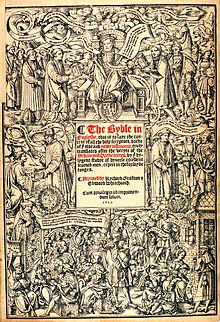Edward Whitchurch

Edward Whitchurch (Pseudonym: Robert Stoughton;
Whitchurch and Richard Grafton jointly published the first complete version of the Bible in English in 1539. Other published works included the 1547 A Treatise of Morall Phylosophie, contayning the Sayinges of the Wyse, by William Baldwin, and the Paraphrases of Erasmus in 1548.[3]
After Thomas Cromwell's fall and execution, Whitchurch and Grafton were sent to prison on 8 April 1543 but they were released on 3 May. On 28 January 1543-4, together Grafton and Whitchurch received an exclusive patent for printing church service books and on 28 May 1546 they were also granted an exclusive right to print primers in Latin and English.[4]
In 1549 he employed five assistants.[5]
After the accession of Mary, he left England, possibly to Germany, and later married Margaret, widow of Archbishop Cranmer in 1556.[8]
See also
References
- ProQuest 2248507609.
- ^ "Vermigli, Pietro Martire, 1499-1562 | The Online Books Page". onlinebooks.library.upenn.edu. Retrieved 18 February 2024.
- ISBN 9781139431569– via Google Books.
- ^ Lee, Sidney (1900). "Edward Whitchurch". Dictionary of National Biography, 1885-1900.
- ISBN 9781108026765– via Google books.
- ^ "A Conversation and Management Plan for Merton Priory and Merton Abbey Mills, p. 7.
- ^ "A Condensed History of Morden and St Lawrence", Church of St Lawrence official website, accessed 17 April 2017.
- doi:10.1093/ref:odnb/29233. (Subscription or UK public library membershiprequired.)
- Attribution
 This article incorporates text from a publication now in the public domain: "Whitchurch, Edward". Dictionary of National Biography. London: Smith, Elder & Co. 1885–1900.
This article incorporates text from a publication now in the public domain: "Whitchurch, Edward". Dictionary of National Biography. London: Smith, Elder & Co. 1885–1900.
